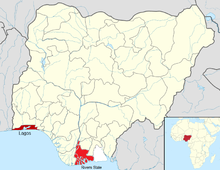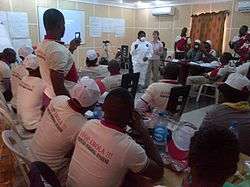Ebola virus disease in Nigeria
 | |
| Disease | Ebolavirus |
|---|---|
| First case | 6 August 2014 |
| Origin | Patrick Sawyer |
| Deaths | 8 |
| Confirmed cases | 20 |
Ebola virus disease in Nigeria occurred in 2014, the epidemic of Ebola virus disease (commonly known as "Ebola") in Guinea represents the first ever outbreak of Ebola in a West African country. Previous outbreaks have been confined to countries in Central Africa.[1] The epidemic, which began with the death of a 2-year-old boy in December 2013, is now part of a larger Ebola virus epidemic in West Africa which has spread through Guinea and the neighboring countries of Liberia and Sierra Leone, with smaller outbreaks occurring in Senegal, Nigeria, and Mali.
Epidemiology
| Articles related to the |
| West African Ebola virus epidemic |
|---|
 |
| Overview |
| Nations with widespread cases |
| Other affected nations |
| Other outbreaks |
West African Outbreak
On 25 March 2014, the World Health Organization (WHO) reported that Guinea's Ministry of Health had reported an outbreak of Ebola virus disease in four southeastern districts, with suspected cases in the neighbouring countries of Liberia and Sierra Leone being investigated. In Guinea, a total of 86 suspected cases, including 59 deaths had been reported as of 24 March.[2]
Researchers generally believe that a one-year-old boy,[3] later identified as Emile Ouamouno, who died in December 2013 in the village of Meliandou, Guéckédou Prefecture, Guinea, was the index case of the current Ebola virus disease epidemic.[4][5] His mother, sister, and grandmother then became ill with similar symptoms and also died. People infected by those initial cases spread the disease to other villages.[6][7]
Although Ebola represents a major public health issue in sub-Saharan Africa, no cases had ever been reported in West Africa and the early cases were diagnosed as other diseases more common to the area. Thus, the disease had several months to spread before it was recognized as Ebola.[5][6]
Index Case
The index case in Nigeria was a Liberian-American, Patrick Sawyer, who flew from Liberia to Nigeria's most populous city of Lagos on 20 July 2014. Sawyer became violently ill upon arriving at the airport and died five days later. In response, the Nigerian government observed all of Sawyer's contacts for signs of infection and increased surveillance at all entry points to the country.[8]
Subsequent Transmission
On 6 August 2014, the Nigerian health minister told reporters, "Yesterday the first known Nigerian to die of Ebola was recorded. This was one of the nurses that attended to the Liberian. The other five newly confirmed cases are being treated at an isolation ward."[9] On 19 August, it was reported that the doctor who treated Sawyer, Ameyo Adadevoh, had also died of Ebola disease.[10]
On 22 September 2014, the Nigeria health ministry announced, "As of today, there is no case of Ebola in Nigeria. All listed contacts who were under surveillance have been followed up for 21 days." According to the WHO, 20 cases and 8 deaths have been confirmed, along with the imported case, who also died. Four of the dead were health care workers who had cared for Sawyer. In all, 529 contacts had been followed and of that date they had all completed a 21-day mandatory period of surveillance.[11]
Outbreak successfully contained

On 9 October 2014, the European Centre for Disease Prevention and Control (ECDC) acknowledged Nigeria's positive role in controlling the effort to contain the Ebola outbreak. "We wish to thank the Federal Ministry of Health, Abuja, Nigeria, and the staff of the Ebola Emergency Centre who coordinated the management of cases, containment of outbreaks and treatment protocols in Nigeria." Nigeria's quick responses, including intense and rapid contact tracing, surveillance of potential contacts, and isolation of all contacts were of particular importance in controlling and limiting the outbreak, according to the ECDC.[12] Complimenting Nigeria's successful efforts to control the outbreak, "the usually measured WHO declared the feat 'a piece of world-class epidemiological detective work'."[13]
The WHO's representative in Nigeria officially declared Nigeria to be Ebola free on 20 October after no new active cases were reported in the follow up contacts, stating it was a "spectacular success story".[14]
Relief contributions to West Africa
On 14 August 2014 the Nigerian government said Aliko Dangote have donated $1 million to halt the spread of the Ebola virus outbreak.[15]
On 5 November 2014 volunteer medical workers arrived in Liberia and Sierra Leone from Nigeria. The first arrivals included 100 volunteers in Freetown, Sierra Leone and a further 76 in Liberia. Nigeria has announced it will be sending 600 volunteers in the coming weeks to help stem the spread of the disease.[16]
Healthcare in Nigeria

Health care delivery in Nigeria is a concurrent responsibility of the three tiers of government in the country, and the private sector.[17] Nigeria has been reorganizing its health system since the Bamako Initiative of 1987, which formally promoted community-based methods of increasing accessibility of drugs and health care services to the population, in part by implementing user fees.[18] The new strategy dramatically increased accessibility through community-based healthcare reform, resulting in more efficient and equitable provision of services. A comprehensive approach strategy was extended to all areas of health care, with subsequent improvement in the health care indicators and improvement in health care efficiency and cost.[19]
The Nigerian health care system is continuously faced with a shortage of doctors known as 'brain drain', because of emigration by skilled Nigerian doctors to North America and Europe. In 1995, it was estimated that 21,000 Nigerian doctors were practising in the United States alone, which is about the same as the number of doctors working in the Nigerian public service. Retaining these expensively trained professionals has been identified as one of the goals of the government.[20]
Despite this, in the 2014 Ebola outbreak, Nigeria was the first country to effectively contain and eliminate the Ebola threat that was ravaging three other countries in the West African region. The Nigerian unique method of contact tracing became an effective method later used by countries, such as the United States, when Ebola threats were discovered.[21][22][23]
See also
References
- ↑ "Ebola virus disease Fact sheet No. 103". World Health Organization. September 2014.
- ↑ "Previous Updates: 2014 West Africa Outbreak". Centers for Disease Control and Prevention. Retrieved 11 April 2015.
- ↑ Kevin Sack, Sheri Fink, Pam Belluck and Adam Nossiter Photographs by Daniel Berehulak (December 29, 2014). "How Ebola Roared Back: For a fleeting moment last spring, the epidemic sweeping West Africa might have been stopped. But the opportunity to control the virus, which has now caused more than 7,800 deaths, was lost.". The New York Times. The Times Company. Retrieved December 30, 2014.
“The messages about don’t touch the dead, wash your hands, if somebody is sick, leave them — these were all strange things, completely contrary to our tradition and culture.”
Anchor cite of important article, do not remove - ↑ "Ebola: Patient zero was a toddler in Guinea - CNN.com". CNN. 28 October 2014. Retrieved 29 October 2014.
- 1 2 Baize, Sylvain; Pannetier, Delphine; Oestereich, Lisa; Rieger, Toni (16 April 2014). "Emergence of Zaire Ebola Virus Disease in Guinea — Preliminary Report". New England Journal of Medicine. 371 (15): 1418–25. doi:10.1056/NEJMoa1404505. PMID 24738640.
- 1 2 Grady, Denise; Fink, Sheri (9 August 2014). "Tracing Ebola's Breakout to an African 2-Year-Old". The New York Times. Retrieved 11 April 2015.
- ↑ Nassos Stylianou (27 November 2014). "How world's worst Ebola outbreak began with one boy's death". BBC News. Retrieved 11 April 2015.
- ↑ "Nigeria 'on red alert' over Ebola death in Lagos". BBC News. 26 July 2014. Retrieved 27 July 2014.
- ↑ Mark, Monica (6 August 2014). "Ebola Outbreak: Nurse who Treated First Victim in Nigeria Dies". The Guardian. Retrieved 7 August 2014.
- ↑ "Ebola strikes at the heart of Nigeria: Ameyo, daughter of Kwaku Adadevoh, grand daughter of Herbert Macaulay dies". Thisday. Retrieved 22 August 2014.
- ↑ "Nigeria in first step towards all-clear on Ebola". Yahoo News. 23 September 2014. Retrieved 26 September 2014.
- ↑ Fasina FO; Shittu A; et al. (9 October 2014). "Transmission Dynamics and Control of Ebola Virus Disease Outbreak in Nigeria, July to September 2014". Rapid Communications. Eurosurveillance. Sweden: ECDC. 19 (40).
- ↑ Courage, Katherine Harmon (October 2014). "How Did Nigeria Quash Its Ebola Outbreak So Quickly?". Scientific American.
- ↑ "Nigeria is now free of Ebola virus transmission". WHO. 20 October 2014. Retrieved 20 May 2015.
- ↑ "Nigeria reports one more Ebola case, 11 in total | Top News | Reuters". Af.reuters.com. 2014-08-14. Retrieved 2014-08-20.
- ↑ "Nigerian Ebola volunteers fly into Liberia, Sierra Leone". Yahoo News. 6 December 2014. Retrieved 6 December 2014.
- ↑ Rais Akhtar; Health Care Patterns and Planning in Developing Countries, Greenwood Press, 1991. pp 264
- ↑ "User fees for health: a background". Archived from the original on 28 November 2006. Retrieved 28 December 2006.
- ↑ "Effect of the Bamako-Initiative drug revolving fund on availability and rational use of essential drugs in primary health care facilities in south-east Nigeria". Retrieved 28 December 2006.
- ↑ Anekwe, Mike Chinedu (April 2003). "BRAIN DRAIN: THE NIGERIAN EXPERIENCE (1)". Niger Delta Congress. Retrieved 7 June 2011.
- ↑ Matt Schiavenza (14 October 2014). "Why Nigeria Was Able to Beat Ebola, but Not Boko Haram". The Atlantic. Retrieved 17 April 2015.
- ↑ "US sends experts to study Nigeria's anti-Ebola strategies". The Punch. 3 October 2014. Retrieved 8 May 2015.
- ↑ "US sends medical experts to study how Nigeria tamed Ebola". Vanguard. 2 October 2014. Retrieved 8 May 2015.
Further reading
- Folarin, Onikepe A.; Ehichioya, Deborah; Schaffner, Stephen F.; Winnicki, Sarah M.; Wohl, Shirlee; Eromon, Philomena; West, Kendra L.; Gladden-Young, Adrianne; Oyejide, Nicholas E.; Matranga, Christian B.; Deme, Awa Bineta; James, Ayorinde; Tomkins-Tinch, Christopher; Onyewurunwa, Kenneth; Ladner, Jason T.; Palacios, Gustavo; Nosamiefan, Iguosadolo; Andersen, Kristian G.; Omilabu, Sunday; Park, Daniel J.; Yozwiak, Nathan L.; Nasidi, Abdusallam; Garry, Robert F.; Tomori, Oyewale; Sabeti, Pardis C.; Happi, Christian T. (4 July 2016). "Ebola Virus Epidemiology and Evolution in Nigeria". Journal of Infectious Diseases: jiw190. doi:10.1093/infdis/jiw190. ISSN 0022-1899. Retrieved 13 July 2016.
- Olowookere, Samuel A.; Abioye-Kuteyi, Emmanuel A.; Adekanle, O. (October 2016). "Willingness to participate in Ebola viral disease vaccine trials and receive vaccination by health workers in a tertiary hospital in Ile-Ife, Southwest Nigeria". Vaccine. doi:10.1016/j.vaccine.2016.10.004. ISSN 1873-2518. PMID 27751640.